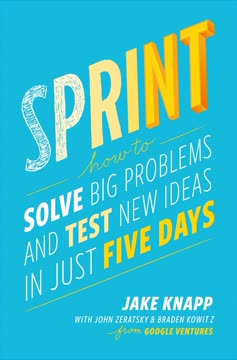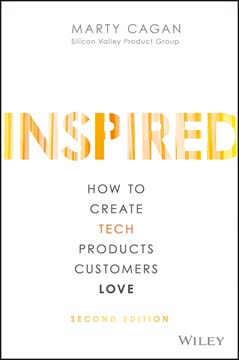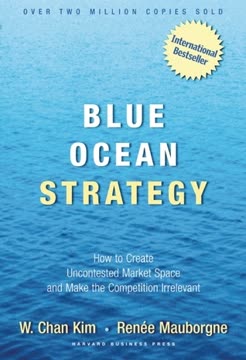Key Takeaways
1. Design thinking is a systematic approach to problem-solving and innovation
Design thinking can do for organic growth and innovation what TQM did for quality—take something we always have cared about and put tools and processes into the hands of managers to make it happen.
Design thinking demystified. Design thinking is not magic or exclusive to designers. It's a systematic problem-solving approach accessible to all managers. It starts with understanding customers deeply and creating a better future for them, acknowledging that the first attempt may not be perfect.
Key principles of design thinking:
- Empathy: Deeply understanding customers' needs and experiences
- Invention: Creating novel solutions to meet those needs
- Iteration: Continually refining ideas based on feedback and learning
Design thinking complements traditional business analysis, bringing a human-centered, creative approach to innovation. It helps managers move beyond incremental improvements to create breakthrough growth opportunities.
2. The design process follows four key questions: What is? What if? What wows? What works?
Design starts with empathy, establishing a deep understanding of those we are designing for.
The four questions framework. The design thinking process can be broken down into four key stages, each centered around a critical question:
- What is? - Explore and understand the current reality
- What if? - Imagine new possibilities and alternatives
- What wows? - Identify the most promising concepts
- What works? - Test and refine ideas in the real world
This framework provides a clear roadmap for innovation projects, ensuring teams thoroughly explore the problem space before jumping to solutions. It balances divergent thinking (generating many options) with convergent thinking (narrowing down to the best ideas).
3. Visualization and journey mapping provide deep customer insights
Journey mapping leads you through your customer's current experience, facilitated by data gathered through observation and interviewing.
Seeing through customers' eyes. Visualization techniques help teams capture and communicate complex information about customer experiences. Journey mapping, in particular, provides a powerful tool for understanding the entire customer experience, including emotional highs and lows.
Key visualization techniques:
- Customer journey maps
- Personas
- Empathy maps
- Storyboards
- Photo and video ethnography
These tools help teams develop empathy for customers, identify pain points and opportunities, and communicate insights effectively within the organization. They provide a shared understanding that fuels innovative thinking in later stages.
4. Brainstorming and concept development generate innovative solutions
Creating new concepts depends a lot more on discipline than on creativity.
Structured ideation. Effective brainstorming requires more than just free-form idea generation. It demands careful preparation, clear ground rules, and a structured approach to capturing and building on ideas.
Key elements of successful brainstorming:
- Diverse team composition
- Clear problem framing
- Trigger questions to stimulate thinking
- Building on others' ideas
- Quantity over quality initially
Concept development takes the raw output of brainstorming and transforms it into coherent, fully-formed solution concepts. This involves clustering related ideas, identifying themes, and combining elements to create robust proposals that can be evaluated against design criteria.
5. Assumption testing and rapid prototyping refine ideas efficiently
Prototyping uses an affordable loss calculation: What is learning worth?
Learning fast and cheap. Assumption testing helps teams identify the critical unknowns that could make or break a new concept. By explicitly stating assumptions and designing experiments to test them, teams can quickly validate or invalidate ideas before investing significant resources.
Rapid prototyping brings concepts to life quickly and inexpensively. Key principles include:
- Start simple (e.g., paper prototypes)
- Focus on learning, not perfection
- Iterate rapidly based on feedback
- Test specific elements as well as whole concepts
This approach allows teams to explore multiple options, fail fast, and refine ideas based on real-world feedback, significantly reducing the risk of large-scale failure later in the process.
6. Customer co-creation and learning launches validate concepts in the market
Any time you introduce an unfamiliar concept, you can expect to get it mostly wrong. That is why co-creation, using low-cost, low-fidelity prototypes, is so essential to reducing the risks and improving the speed of successful innovation.
Partnering with customers. Co-creation involves engaging potential customers in developing new offerings. This collaborative approach ensures solutions truly meet customer needs and builds buy-in early in the process.
Learning launches take promising concepts into the market for real-world testing. Key principles:
- Set clear learning objectives
- Define success metrics upfront
- Constrain time, geography, or customer segments
- Design for fast feedback cycles
- Be prepared to iterate or pivot based on results
These approaches bridge the gap between concept and full-scale launch, providing valuable data to inform go/no-go decisions and refine offerings before major investments are made.
7. Implementing design thinking requires careful team selection and momentum management
As long as a project is clicking along and people feel productive, there is a positive buzz. The number one momentum builder is speed.
Building for success. Implementing design thinking in organizations requires more than just learning the tools and process. It demands careful attention to team composition, project selection, and maintaining momentum.
Key considerations for successful implementation:
- Start small with manageable projects
- Select diverse, cross-functional teams
- Secure executive sponsorship
- Create dedicated project spaces ("war rooms")
- Establish regular check-ins and clear decision-making processes
- Celebrate small wins and learning from failures
By focusing on these elements, organizations can create an environment where design thinking thrives, leading to sustained innovation and growth.
Last updated:
FAQ
What's "Designing for Growth" about?
- Design Thinking for Managers: "Designing for Growth" by Jeanne Liedtka and Tim Ogilvie is a guide for managers on how to apply design thinking to drive business growth.
- Toolkit Approach: The book provides a toolkit of ten design thinking tools that managers can use to innovate and solve complex business problems.
- Structured Process: It outlines a structured process involving four key questions: What is? What if? What wows? and What works? to guide managers through the design thinking journey.
- Practical Examples: The book includes real-world examples and case studies to illustrate how design thinking can be applied in various business contexts.
Why should I read "Designing for Growth"?
- Practical Application: It offers practical tools and methods that managers can directly apply to their work to foster innovation and growth.
- Structured Framework: The book provides a clear, structured framework for implementing design thinking, making it accessible even to those new to the concept.
- Real-World Success Stories: It includes success stories from companies like AARP and Kaiser Permanente, demonstrating the effectiveness of design thinking in real business scenarios.
- Enhance Problem-Solving Skills: Reading this book can enhance your problem-solving skills by teaching you how to approach challenges creatively and strategically.
What are the key takeaways of "Designing for Growth"?
- Four Key Questions: The design thinking process is structured around four questions: What is? What if? What wows? and What works? These guide the exploration, ideation, and implementation phases.
- Ten Essential Tools: The book introduces ten tools, such as journey mapping and rapid prototyping, that are essential for applying design thinking in business.
- Customer-Centric Approach: Emphasizes the importance of understanding customer needs and involving them in the design process to create value.
- Iterative Learning: Encourages an iterative approach to innovation, where assumptions are tested and refined through prototypes and customer feedback.
How does "Designing for Growth" define design thinking?
- Systematic Approach: Design thinking is defined as a systematic approach to problem-solving that starts with understanding customer needs and creating a better future for them.
- Empathy, Invention, Iteration: It involves empathy for the user, invention of new solutions, and iteration to refine those solutions.
- Beyond Aesthetics: The book differentiates design thinking from traditional design by focusing on business growth and problem-solving rather than just aesthetics.
- Accessible to Managers: It argues that design thinking can be taught to managers and applied in business contexts to drive innovation.
What are the four key questions in "Designing for Growth"?
- What is?: This question focuses on understanding the current reality and identifying the real problem or opportunity.
- What if?: This stage involves envisioning new possibilities and generating creative ideas for the future.
- What wows?: Here, the focus is on selecting the most promising ideas that have the potential to create significant value.
- What works?: This final stage involves testing the ideas in the marketplace to see which ones are viable and can be scaled.
What are the ten tools of design thinking in "Designing for Growth"?
- Visualization: Using imagery to envision possibilities and bring them to life.
- Journey Mapping: Assessing the existing experience through the customer's eyes.
- Value Chain Analysis: Evaluating the current value chain that supports the customer's journey.
- Mind Mapping: Generating insights from exploration activities and creating design criteria.
- Brainstorming: Generating new possibilities and alternative business models.
- Concept Development: Assembling innovative elements into a coherent solution.
- Assumption Testing: Isolating and testing key assumptions that will drive success.
- Rapid Prototyping: Expressing a new concept in a tangible form for exploration.
- Customer Co-Creation: Involving customers in creating the solution that best meets their needs.
- Learning Launch: Creating an affordable experiment to test key assumptions with market data.
How does "Designing for Growth" suggest using visualization?
- Mother of All Tools: Visualization is considered a fundamental tool used in every stage of the design thinking process.
- Reduces Misinterpretation: It helps reduce project risk by making ideas tangible and reducing the chances of misinterpretation.
- Engages Right Brain: Visualization engages the right brain, which is responsible for emotion and intuition, aiding in decision-making.
- Various Forms: It can take many forms, including storyboards, sketches, and personas, to help communicate ideas effectively.
What is journey mapping according to "Designing for Growth"?
- Customer Experience Focus: Journey mapping is about representing the customer's experience in a flowchart or graphic format.
- Identifies Pain Points: It helps identify emotional highs and lows in the customer's journey, revealing opportunities for improvement.
- Empathy Building: By walking in the customer's shoes, it builds empathy and a deeper understanding of their needs.
- Foundation for Innovation: It serves as a foundation for generating innovative ideas that enhance the customer experience.
How does "Designing for Growth" recommend conducting brainstorming?
- Structured Process: Brainstorming should be a structured process with clear ground rules to encourage creativity and prevent critiques.
- Diverse Group: Involves a small, diverse group of people to bring in different perspectives and ideas.
- Trigger Questions: Uses trigger questions to stimulate creative thinking and explore new possibilities.
- Follow-Up: Emphasizes the importance of follow-up to convert raw ideas into robust concepts through concept development.
What is assumption testing in "Designing for Growth"?
- Key Assumptions: Assumption testing involves identifying and testing the key assumptions underlying a new business concept.
- Thought Experiments: It uses thought experiments to test assumptions with existing data before moving to market tests.
- Reduces Risk: By focusing on critical assumptions, it reduces the risk of failure by ensuring that only viable concepts move forward.
- Iterative Process: It is an iterative process that helps refine concepts and improve their chances of success.
How does "Designing for Growth" define rapid prototyping?
- Express Concepts: Rapid prototyping is about creating visual or experiential manifestations of concepts to test and refine them.
- Iterative Learning: It is an iterative process that allows for quick learning and refinement of ideas.
- Low-Fidelity Start: Prototypes start as low-fidelity models to invite feedback and collaboration from stakeholders.
- Minimizes Investment: By testing concepts early, it minimizes investment and risk before full-scale development.
What are the best quotes from "Designing for Growth" and what do they mean?
- "Design thinking is actually a systematic approach to problem solving." This quote emphasizes that design thinking is not just about creativity but involves a structured process to address business challenges.
- "Empathy, invention, and iteration." These three words capture the essence of design thinking, highlighting the importance of understanding users, creating new solutions, and refining them through feedback.
- "Fail fast to succeed sooner." This quote underscores the value of rapid prototyping and learning from failures quickly to achieve success in innovation.
- "Visualization is the mother of all design tools." It highlights the critical role of visualization in making ideas tangible and facilitating communication and collaboration.
Review Summary
Designing for Growth receives mixed reviews, with an average rating of 3.99 out of 5. Readers appreciate its visual appeal and introduction to design thinking concepts, finding it useful for beginners. Some praise its practical tools and case studies, while others criticize the surface-level explanations and lack of depth for experts. The book's structure and organizing outlines are generally well-received. However, some readers find it repetitive and overly corporate. Translation quality in non-English versions is frequently criticized. Overall, it's considered a good primer for those new to design thinking.
Similar Books










Download PDF
Download EPUB
.epub digital book format is ideal for reading ebooks on phones, tablets, and e-readers.




